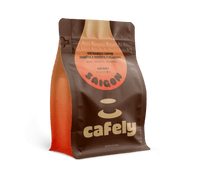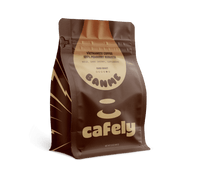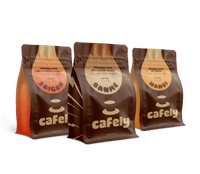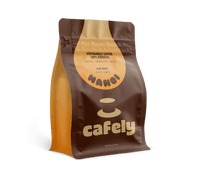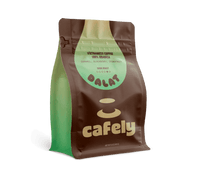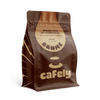The discovery of tea is way older than coffee, and for thousands of years, tea has dominated our cups.
But tea slipped down our list of favorite drinks as we discovered more stimulating herbal beverages.
Tea now only ranks fifth on the list of America's most consumed beverages, with 48% of Americans saying they regularly drink tea.
Coffee — the discovery of which is about 35.9 centuries younger than tea — is the country’s second most consumed beverage at 57%, while bottled water ranked first at 63% [8].
Tea may have lost some of its appeal, but it's still one of the world's most popular beverages.

We’ll trace the origins of tea in this comprehensive timeline to 4,761 years ago.
We’ll go through how it was discovered, who introduced it to the rest of the world, and how it sparked wars and toppled monopolies. We’ll also discuss tea’s impact on our society and economy.
2737 BCE: The Chinese Legend of Emperor Shen Nong
We’ve read several accounts of how tea was discovered, but this Chinese legend is the most famous one by far.
Tea was an accidental brew discovered in China around 2737 BCE by Emperor Shen Nong [44]. He was in his garden one day, boiling a pot of water to drink, when leaves from a nearby Camellia sinensis tree fell into his pot. The leaves immediately infused the hot water and turned it dark. The process also released the leaves’ fragrant aroma, which caught his curiosity.
Curiosity won. The emperor — who was also said to be a skilled herbalist — took a sip of the infused water and liked it so much. He then dedicated some of his time to studying the plant and discovering its health benefits. The emperor even used tea as an antidote for 72 types of poisonous plants.

200 CE: Tea Drinking Spreads in China
Tea drinking had already spread in China around the 3rd century CE, thanks to travelers and merchants [54].
Not only had they spread the habit to other regions, but also brought with them the knowledge of growing a tea plant. In time, more regions began cultivating tea plants and processing their leaves.
350 CE: First Authentic Record of Tea Traced to 350 CE
The earliest authentic record of tea appeared in an ancient Chinese dictionary, which was revised by Kuo P'o, a renowned Chinese scholar, around 350 CE [28].
In it, he described the methods of cultivating, boiling, and drinking tea [54].
581–618 CE: Tea is Used as Medicine During the Sui Dynasty
Tea was more than just a drink during the Sui Dynasty; it was traditionally used as a medicinal herb to support health [11].
The ancient Chinese ground the dried tea leaves into powder before compressing them into blocks of cakes. To use, they would simply break off a piece and drop it into boiling water. They would also even add other ingredients like ginger, mint leaves, and orange peel into the pot, a practice that would carry over to the Tang Dynasty [32].

600–650 CE: Tea Reaches Korea
Tea drinking spread from China to Korea via the Silk Road during the reign of King Seondeok in the 7th century [37]. As close neighbors, the Korean tea culture was heavily influenced by the Chinese.
By the 20th century, the Japanese would significantly influence the country’s tea culture.
When Japan occupied Korea in 1910, they brought with them their own highly ritualized tea ceremony. The Japanese government later taught its distinctive style in some Korean schools.
618–907 CE: The Tang Dynasty Formally Acknowledges Tea as Medicine
The Tang Dynasty formally acknowledged tea as a safe medicine with no toxicity in their Xin Xiu Ben Cao, a pharmacopeia that listed medicinal herbs and their uses. People used tea for many reasons — from quenching thirst to treating phlegm [75]. They would also add salt to their tea, a tradition that the Tibetans are still doing today [32].
Adding salt to tea may seem odd now, but it was common practice in ancient China. People didn’t view tea as a beverage back then but as an ingredient like salt to use in their soup [74].
Many Americans nowadays still consider tea as beneficial to their health. While more than half (53%) say they drink tea because they like the taste, about 1 in 5 (21%) drink it for health reasons [33].
At least 2 in 5 (40%) drink tea to help them relax, while a little over 1 in 10 (13%) say it aids with digestion.

700 CE: The First Teahouses Appears in China
The first recorded mention of teahouses began popping up during the Tang Dynasty, as written in the Feng Shi Tourist and Sketch Book [38].
According to the book, more teashops were opening, and the concept was gradually reaching the capital. These shops would boil tea and sell the drink to their guests.
Chang-an, in particular, had a flourishing teashop culture. These establishments would advertise tea as a medicine to attract patrons [13].
800 CE: Tea Reaches Japan
Tea reached Japan during the early 9th century and was said to have been introduced by Saicho, a Japanese Buddhist monk [54].
Saicho went to China around that period to study religion and learned to drink tea during his stay. When he went back to Japan, he brought with him some seeds to plant at his monastery so he could continue his tea-drinking habit, a habit that would also spread to other monks.
Although highly influenced by the Chinese, the Japanese Zen monks also developed their own tea ceremonies and mostly used them for meditations [38].
It wasn’t long before the ancient Japanese also began cultivating tea plants for consumption.
960–1279: The Song Dynasty Popularizes Powdered Tea, the Precursor to Matcha
Contrary to popular belief, matcha didn’t originate in Japan [29]. The tradition of adding boiling water to powdered tea and whisking it with a bamboo whisk actually came from China and was popularized by the Song Dynasty [11].
The Song Dynasty revolutionized tea preparation and introduced us to a new method of using powdered tea instead of tea cakes. The technique soon spread to other regions and, in Japan, became the precursor to matcha. While the tradition of using powdered green tea flourished in Japanese culture, it slowly disappeared in China after the Yuan Dynasty (1279 CE to 1368 CE).
Teahouses had already become social hubs during the Song Dynasty. People gathered in these shops not only to enjoy tea but also to socialize, conduct business, or be entertained [38].
A robust trading system between China and Eurasia had also already been established, but China maintained a monopoly on the tea trade since the Tang Dynasty [10].

1127–1279: Tea Reaches the Middle East
The Silk Road is a series of trade routes connecting Asia to Europe and was one of the many ways that tea reached the Middle East. It had been used by traders since 130 BCE when China’s Han Dynasty first opened trade with its neighboring regions [67].
According to history, tea reached the Middle East during the Southern Song Dynasty (a period that lasted from around 1127 to 1279) [25]. Arab merchants traveled to Quanzhou in China’s Fujian Province to trade goods, including tea. The merchants brought tea back home from the city of Quanzhou, spreading it to Middle Eastern countries where tea became an alternative to wine and haram beverages.
1279–1368: The Yuan Dynasty Shifts from Powdered to Steeped Tea
The method of preparing tea shifted yet again when the Mongolian Yuan Dynasty conquered China.
Before the Yuan Dynasty, drinking powdered tea was fashionable. But as the Yuan Dynasty ruled they also introduced a newer and simpler way of making tea — steeping tea leaves.
Little by little, the use of powdered tea disappeared from Chinese culture, and steeping tea became the country’s common way of drinking tea [11].
1332: Earliest Recorded History of Adding Dairy to Tea
The earliest recorded mention of adding dairy products to tea can be traced back to the Mongols in a 1332 CE food and medicine manual called Yin Shan Zheng Yao [40].
Hoshoi, the Mongolian court doctor during that period, wrote in his manual how to use butter and curd in tea. By the 16th century, the Mongols adopted the Tibetan way of using horse milk in their tea, instead of yak butter.
No one knows exactly when the Tibetans first started using dairy products in their tea. However, the practice may have begun soon after China introduced tea to Tibet during the Tang Dynasty (618-907 CE) [16]. Around that period, Tibetans used dairy products heavily in their diet to add calories and boost nutrition, so it wouldn’t be surprising that they also began adding dairy products to tea.
1368–1644: Tea Wares Become a Major Form of Art During the Ming Dynasty
The Ming Dynasty revolutionized China’s teashop industry, further enriching the country’s tea culture [13]. They transformed simple tea wares into an art form. Teas and teapots became even more elegant and elaborate in design, making them sought-after luxury items.
The Silk Road during this period was already a busy, major route where merchants from neighboring regions traded goods like silk and tea. While this contributed to the spread of tea culture to other countries, China maintained sole control over the tea trade.
1400s: The Concept of Teahouses Reaches Japan
The teahouse concept reached Japan by the mid-15th century, during the Sengoku period [60]. However, the culture surrounding these teashops remained largely influenced by the Zen philosophy, focusing more on simplicity and tranquility.
Instead of places to socialize, Japan’s teahouses were places where you find peace and quiet. They’re often small and simple in design, so the guest can focus on the ceremony itself.

1500s: Japanese Tea Master Sen no Rikyu Perfects the Tea Ceremony
In the 16th century, Tea Master Sen no Rikyu revolutionized Japan’s tea ceremony [62]. He essentially formalized their tea ceremony’s complex processes, steps, and traditions.
Sen no Rikyu favored simple and rustic designs, from tea wares to the teahouse itself, over large, elegant spaces. He also emphasized the ritualistic and meditative aspects of the tea ceremony, returning it to its Zen roots.
Under the famous tea master, the country’s tea ceremony became more than just a spiritual and cultural experience but also an art.
1560: Tea Reaches Portugal
It was technically the Portuguese who brought the first tea to Europe. Their missionaries and merchants arrived in China somewhere around 1560 and established a direct trade line with the region. When they returned home, they brought with them tea [2,30].
But for commercially imported tea, we have to give that credit to the Dutch.
1610: The Dutch Initiate the Commercial Tea Trade Between China & Europe
Trade between China and Europe may have started as early as 206 BC during the Han Dynasty [46]. However, commercial tea only reached Europe in 1610, thanks to the Dutch merchants, particularly the Dutch East India Company. They brought the very first shipment of commercial Chinese tea to Amsterdam, the Netherlands. Like in Asian countries, tea quickly became a part of the Dutch lifestyle and soon spread to neighboring regions.
Eurasian commercial tea trade flourished, with the Dutch East India Company controlling the trade in Europe [26].

1624: Tea Reaches the Americas
The first Dutch colonists arrived in New Amsterdam (now New York) in 1624, and they brought with them their love for tea [1,71]. By the mid-17th century, the practice had already spread to other colonies, and tea drinking became a part of the colonists’ daily life.
Tea would continue to dominate the cups of Americans for almost one and a half centuries — that is, until coffee and patriotism ended its reign in 1773 after the Boston Tea Party.
Today, around 3 in 4 (75%) Americans drink coffee [15].
The US is also the biggest coffee importer in the world and has the highest domestic consumption [48].
- By 2024/2025, the US will have imported 26 million 60-kg bags of coffee, comprising 18.4% of the total global coffee imports (141.5 million 60-kg bags).
- The US will also have consumed around 26.1 million 60-kg bags by 2024/2025, making up 15.3% of the world’s total domestic consumption of 170.6 million 60-kg bags.

1650s: Tea Reaches Britain
Britain was a little late to the tea party, with tea only reaching them in the 1650s [64]. But it would play a very big role in tea's history.
Like silk, tea was a very expensive luxury item that only rich people could afford to buy. Tea soon became a social status symbol, with wealthy aristocrats, including the Royal Family, adopting China’s tea culture — from preparing the tea leaves to brewing and serving tea.
Tea became quite a hit in Europe, and Europe became China’s biggest tea buyer. Their demand for tea even prompted several Chinese provinces to focus on tea cultivation to keep up with the demand [6].
1657: Tea Trade Starts in England
England’s tea trade began in 1657, and we can trace it back to Thomas Garway. He was the first coffee and tea retailer who publicly sold tea in leaf and drink forms [24].
Tea culture had already spread to other parts of Europe by then, including Italy, France, and Holland. But tea largely remained a nobleman’s drink, a medicine believed to cure many illnesses. Garway, to attract customers, highlighted tea’s health benefits in his printed advertisements.
England, during this period, also strengthened its presence in Asia. Fueled by its competition with the Dutch, England gave its own English East India Company more power not only to trade but also to enforce the government’s laws on its Asian territories and subjects. Pretty soon, the Company became a dominant force that would surpass the Dutch in trade in the East [26].
1662: Tea Shifts From Medicine to Social Beverage
Tea was treated more like a medicine before. But when Princess Catherine of Braganza, Portugal, married King Charles II of England in 1662, people’s perception of tea as a medicine shifted [12].
Portugal, at that time, already had a colony in Macau, so it had a direct trade route to China. Long before tea ever reached England, the Portuguese aristocrats were already regularly drinking tea, a habit that the princess grew up with.
Princess Catherine naturally brought the habit with her when she married the King of England. As the new queen, she became the center of everyone’s attention, and people soon noticed and copied her tea-drinking habit. Through her, tea became more than just a medicine but also a social beverage, especially among the Royal Court’s inner circle.
Tea, as a social beverage, was not the only thing England learned from Portugal. As part of the princess’s dowry, Portugal gave England the port of Bombay (now Mumbai). The port would later play a significant, darker role in tea history.
1680: Milk Tea Appears in Europe
Dairy products in tea have long been a tradition in the East, with some historians saying it started around the 7th century in ancient Tibet. By the 17th century, milk tea had become a staple among China’s elite, with the ruling Manchu court of the Qing Dynasty giving tea with cow’s milk imperial prestige. The dynasty also popularized the use of aromatic flowers like jasmine and rose in their teas [40].
Adding milk to tea started gaining traction in Europe around 1680, thanks to Madame de la Sablière. She popularized the practice in Paris when she started serving tea with milk at her salon.
1685: China Eases Restrictions on European Trade
Since time immemorial, the Chinese controlled the world’s tea trade. If Europe wanted its tea, then it better pay China in silver to get that tea.
Emperor Kangxi of the Qing Dynasty wanted to increase the flow of Europe’s silver into China, so he eased the restrictions on European trade in 1685 [26]. This move ultimately gave England direct access to the tea trade. It also allowed the English to finally push the Dutch out and take control of the tea trade monopoly.
1700: Tea Becomes Britain’s National Identity
The Brits overtook the Dutch’s hold on the Asian trade during the 1700s. England, around this period, had already become the leading trader between the Asian and European markets [26].
With better access to the much-coveted tea, England's tea-drinking habit became more mainstream and extended beyond the wealthy aristocrats. Gradually, tea became further intertwined with the British lifestyle and grew into a significant part of its national identity.
Britain’s tea consumption had also increased significantly. In the 1690s, they were only importing a few hundred pounds of tea. As the English East India Company’s strength grew, so did the importation of tea, reaching 29 million pounds by 1757, more than half of which (17 million pounds) were stored in warehouses. By 1780, England was importing 9.4 million kilos of tea.
Today, the United Kingdom is still one of the top tea importers, but it's now only third to Pakistan. In 2023, the UK’s tea imports amounted to $310.4 million in trade value, 1.9 times lower than Pakistan’s $588 million. America lands second place with $519.8 million in trade value [69].

1706: Thomas Twinning Sells His First Tea in London
Thomas Twining, founder of Twining, initially spent five years learning about the tea industry under a wealthy merchant. Seeing the industry’s potential, he bought Tom’s Coffee House in 1706 and served not just coffee but tea as well [65].
It wasn’t long before his customers began buying more dry than wet tea. Over time, Twining began selling dry tea not just to his customers but also to wealthy households. He also supplied tea to other coffeehouses.
1710: Tea is Sold in Grocery Shops For the First Time
Tea became even more accessible to the Brits. By 1710, tea was being sold in many grocers’ shops [26].
The drink is no longer just for the wealthy to be enjoyed in elegant gardens and drawing rooms. But you can find them in stores and shops, ready for anyone with money to buy and brew at home.
1750s: Contemporary Chinese Teas Are Classified Into Three Categories
Three major types of contemporary Chinese tea have emerged around the mid-18th century [23]:
- Black tea or hong cha — Fully fermented tea
- Oolong or ging cha — Semi-fermented tea
- Green tea or lu cha — Unfermented tea
Today, we have more types of teas than we can count. These include not just the True Teas (traditional teas from Camellia sinensis) but also teas made from herbs, flowers, fruits, roots, seeds, and tea blends!
We may have many options now, but traditional teas remain the most popular teas in the US. About 1 in 2 (50%) tea drinkers prefer green tea, while almost the same percentage (48%) like black tea [34].
More than one-third (38%) of American tea drinkers like herbal tea, while nearly one-fourth (24%) enjoy drinking fruit teas.

Late 1700s: (Britain & China): Britain’s Great Tea Robbery
War expenses, colonial expansion, and a voracious appetite for tea were draining Britain's silver reserves and increasing its payment deficits.
With nothing to offer China in exchange for tea, Britain was losing more of its silver to tea. They needed to find a way to finance their tea and, at the same time, cover their payment deficits without losing more silver to China.
Their solution?
India [26].
How India’s Opium Trade Financed Britain’s Tea
Poppy for tea, poppy for silver…and control in our hands.

Poppy plants grew abundantly in Bengal, where the Brits had political control. By 1773, they took over India’s opium trade and cultivated the plant to produce more of the addictive opium [63]. They then had their network of private traders sell opium in India’s open market and smuggle the drug into China, which had a very receptive market at that time. Some of these opium auctions were held in Bombay and transported to China via its port [21].
Opium turned out to be a lucrative business for the Brits. Not only did they receive significant profits, but their private network also allowed them to distance themselves from the opium trade.
China’s opium consumption rose fourfold. Before the Brits’ involvement, China’s opium consumption averaged around 1,000 chests yearly. By the late 18th century (1770 to 1800), the Chinese were already consuming about 4,000 chests annually. This spiked 7.5 times more by 1836, with the country consuming 30,000 chests of opium.
China wasn’t happy and demanded that foreign traders and merchants surrender their opium stocks. They also dumped into the Pearl River about 2.6 million pounds of opium in 1839 (an act that would be echoed in the Boston Tea Party, but more on that later!). Britain then retaliated by sending its troops to China, triggering the First Opium War.
After a fierce two-year battle, China surrendered to Britain and was forced to open its ports to trade. The country also surrendered Hong Kong to Britain.
How India Toppled China’s Tea Monopoly with Britain’s Stolen Secrets
Tea for kings, tea for all…and money in our pockets.

Britain may have the means to buy China’s tea, but it still depended on China for its supply. Tea production remained China’s well-guarded secret. The Chinese government wouldn’t even allow foreigners in all its tea-producing districts.
In the 1820s, British soldiers discovered wild tea plants growing in Assam, India. Seeing the opportunity to break free from their dependence on China, Britain developed the region and forced Indian laborers to work for minimal pay.
The first shipments of Assam tea were sold in 1839, but they were inferior in quality. Britain knew then that it needed to find out how China produced its tea.
When diplomacy failed to convince China to share its tea secrets, Britain had only one option left — steal.
They sent Robert Fortune, a Scottish botanist, to China in 1848 with only one mission — to find out how China makes its tea.
For three years, Fortune, disguised as a Chinese merchant, went from one tea-producing district to another. He stole not only tea seeds and plants but also observed and recorded the whole tea production process — from planting the seeds to fermenting the leaves. He then sent the seeds and plants to India, where they thrived, thanks to the stolen tea knowledge.
Britain’s tea heist was so successful that, by the 1870s, India was competing with China as a major tea supplier. China was also losing its grip on the tea monopoly.
Late 1700s (America): Tea Taxes Fuel the American Revolution
Meanwhile, things were heating up in America.
Like the Dutch, the English had also arrived in the New Land during the early 1600s to establish colonies. As their power grew in America, so did their hunger to expand their colonies. By 1664, the English had wrested New Amsterdam from the Dutch [66].
Britain’s quest for power, land, and trade dominance had been successful, but it also landed them in tremendous debt. To help cover those debts, Britain began imposing increasing taxes on American colonists.
They taxed almost everything the American colonists needed — from printed paper to daily essentials like tea — commodities that the British East India Company had a monopoly on. This further sparked the colonists’ anger, who were already itching for independence from Britain by the 1770s [61].
The rising taxes led to protests and boycotts, widening the rift between Britain and America [72].
December 16, 1773: The Boston Tea Party
On the night of December 16, men dressed in Native American clothes (many of whom were members of the Sons of Liberty) boarded three docked ships bearing precious tea from China and threw tea into the Boston Harbor. According to history, it took the men about three hours to dump all chests into the sea [47].
The Boston Tea Party, carried out by over 100 colonists, cost Britain 342 chests carrying 45 tons (90,000 pounds) of tea. In today’s money, the shipments would have cost $1.7 million [39].
The act did not go unpunished, of course. Britain passed the Coercive Acts, forcing the colonists to pay for the loss and ending their free elections, among other punitive laws. However, as Britain escalated its efforts to quell America's rebellion, the colonists' resistance also intensified.
Tea dumping protests became a common form of rebellion in America. There was a second but less popular Boston Tea Party in March of 1774. Similar protests also occurred in Philadelphia, Massachusetts, New Jersey, and New York. In total, there had been 17 tea parties before the American Revolution [18].
The colonists also boycotted tea and began drinking coffee to show their patriotism. This shift slowly turned America from a tea-drinking country to a coffee-loving one.

1800s: China's Tea Monopoly Crumbles
China no longer had a monopoly on tea, with India becoming a major player in the tea trade. Tea was no longer just for the elite to enjoy. It became more mainstream, especially among the upper middle class.
With tea becoming more affordable, it wasn’t long before tea rooms began popping up all over Britain, serving not just tea but home-baked pastries as well [64].
Britain’s quest to expand its territories also contributed to the widespread cultivation and production of tea around the world.
- Australia’s first commercial tea plantation was established around 1886 by the Cutten brothers, almost a century after the Brits arrived in 1788 [14,43].
- The Brits brought tea plants to Ceylon (now Sri Lanka) in 1824. By 1867, the first tea plantation opened, pioneered by James Taylor [9].
- They brought tea seedlings to Kenya in 1903. By 1924, the country began its commercial cultivation of tea [27].
The changing times also affected the English East India Company’s powerful influence in Britain. Increasing demand for free trade, exploitative practices, political pressure, poor performance, needing frequent government bailouts, and growing competition finally led to its dissolution in 1874 [26].
With the collapse of tea monopolies came innovations in cultivation, newer techniques for making tea, and the creation of different tea styles.
1840: The Afternoon Tea
The afternoon tea tradition is often credited to Anna Russell, the 7th Duchess of Bedford [41]. According to stories, the Duchess needed something to tide her over between lunch and dinner. To satisfy her hunger but not spoil her appetite for dinner, she had tea and pastries sent to her room one late afternoon. It soon became a habit that the upper classes also copied. Pretty soon, the tradition spread to other parts of Britain.
Today, tea is still best enjoyed in the late afternoon, says 38.4% of American tea drinkers who enjoy a cup or two at dinner. More than one-fourth (25.5%) enjoy tea with lunch, while only 15.1% drink tea in the morning [55].

A cup of tea or two is usually enough for 45% of tea drinkers. But 14% need more and drink six cups or more a day [36]!

Some may see more than six cups as excessive tea drinking. But you’d need to drink at least 13.6 cups of green tea or 8.4 cups of black tea to reach the daily caffeine limit of 400 mg [57]. In general, a cup of green or black tea contains around 29.4 mg or 47.4 mg of caffeine per 8-oz serving [4–5].

1890: The First Lipton Tea Farm Opens
Thomas Lipton, already a wealthy merchant, wanted to make tea more affordable for more people. In 1890, he went to Ceylon to buy his first tea farm. The country had just switched to planting tea after a fungus decimated its coffee plantations [31].
The move to cultivate tea proved beneficial to Ceylon, as its tea quickly gained a good name in London’s tea auction houses. The move to invest in the tea industry also proved to benefit Lipton. He was able to cut out the middleman and sell tea at a more affordable price. His teas became even more popular when he began selling them in premeasured packets.
Lipton remains a favorite household name in the US today. However, when it comes to bagged and loose-leaf sales, Lipton is only second to Bigelow, a tea brand established in 1945 [68]. Bigelow had 17.6% of the market share in tea sales in 2023. Lipton has 14.3%, while Twinings has 8.9% [52].

1901: Tea Bag Is Invented
Convenience was what pushed two Milwaukeean women to invent the tea bag and apply for its patent in 1901 [19]. The old method was to brew a whole pot of tea, which wasted good tea if you only wanted one cup. Their solution was to use a mesh bag to contain the leaves, allowing you to brew only the amount needed for your cup.
However, there is a second story to how tea bags were invented, and this one came seven years later, in 1908. Thomas Sullivan, an American tea importer, placed tea leaves in silk bags to give as samples to his customers. Some of his customers, thinking the bags were meant for brewing, placed them directly in their cups of hot water. Enjoying the convenience, they began ordering the same.
By the 1950s, tea bags had become very popular in the US, making them a staple in many American homes. Even the Brits, who were not as fond of them initially, also started using tea bags.
Tea bags are still the top choice for enjoying tea in the US today, according to a survey. More than 1 in 2 (51%) use tea bags versus loose leaf. Only 4% prefer loose tea to tea bags [35].

1904: Iced Tea Is Invented
Tea used to be drunk hot. But one hot day at the World’s Fair in St. Louis in 1904, Richard Blechynden had the idea of adding ice to his samples of hot tea, which his customers enjoyed [49]. The new way of enjoying brewed tea became an instant hit, and iced tea has been popular ever since, especially in the South.
Iced tea is still America’s favorite type of tea today. It makes up 75% to 80% of the country’s tea consumption [59].
1947: India Gains Independence & Control of Its Tea Industry
India gained its independence from Britain in 1947 [53]. Along with their independence, they also gained control of British assets, including the tea industry. By 1953, the Indian government had already established the Tea Board of India to oversee the industry [17].
Today, India is still a top tea exporter, but it has lagged behind China, Kenya, and Sri Lanka.
China’s tea export industry amounted to $1.74 billion in 2023, making up 25.7% of the global tea export industry. Kenya and Sri Lanka followed in second and third places with $1.35 billion and $1.29 billion, respectively. India landed fourth place, making up only 10.5% of the global tea export with $706.9 million [69].
Together, these four countries make up 75% of the world’s tea export industry.

1949: The First Bubble Tea Is Prepared
The very first bubble tea was invented by mixologist Chang Fan Shu in Taiwan in 1949 [73]. To make his newly opened tea shop stand out, he began offering hand-shaken (shou yao) tea using cocktail shakers.
Not only was the tea rich and silky, but it also had a thick layer of fine bubbles on top, which the Taiwanese called foam tea. Back then, hot tea was the standard in Taiwan, so this cold, specialty tea was a new trend that quickly became popular.
1986: Bubble Milk Tea Is Invented
Taiwanese businessman and artist Tu Tsong He took Taiwan’s tea shop trend to another level in 1986 when he invented bubble milk tea [73]. Like Chang Fan Shu, he wanted his tea shop to stand out, so he started experimenting with tea.
He initially added fen yuan to his tea. The little white, almost translucent tapioca balls looked like pearls in the green tea, so he called it “pearl green tea.”
For more texture and a richer taste, he then tried the larger black tapioca balls with milk tea. What he created was the classic milk tea we know now, with its creamier taste and chewy black tapioca balls.
His version of bubble tea soon became popular, and the trend that captivated the Taiwanese spread to the rest of the globe.
By the 1990s, bubble milk tea had spread throughout Asia. In the 2000s, it finally reached the American and European shores, where its popularity exploded [45].
The Other Bubble Milk Tea Inventor
Another Taiwanese tea shop, Chun Shui Tang, also claims to be the first inventor of milk tea [73]. According to their story, tea shop owner Liu Han-Chieh was in a meeting with his staff one day in 1988. Lin Hsiu Hui, his product development manager, added tapioca balls to her iced tea just for fun.
The drink was an instant hit with the people in the meeting, so they added bubble milk tea to their menu. In just two months, their bubble tea became their bestselling product.
Chun Shui Tang also claims to be the first inventor of foam tea, saying they were the first to use cocktail shakers to make the bubbles in teas.
Bubble milk tea was a hot, new product, and everyone concerned wanted to claim credit for its invention. By 2009, the issue over who first invented bubble tea finally led to a ligation that lasted ten years.
The bubble milk tea court battle ended in 2019 in an anticlimactic resolution, with no one winning in the litigation. The court ultimately ruled that bubble tea was a drink anyone could make, and knowing who first invented it was not important.
Today, modern bubble milk tea is made with different toppings and can be prepared using different flavor combinations.
How Bubble Milk Tea Became Known as Boba Tea
Bubble tea is boba tea, boba tea is bubble tea, and this nickname is credited to a hawker in Tainan [73]. He wanted to differentiate milk tea from fen yuan milk tea with black tapioca balls, so he called the latter "boba tea."
The name "boba tea" comes from the nickname "Boba" of Hong Kong actress and model Amy Yip, who was famous in the 1980s. In Taiwanese slang, "boba" literally means "large breasts."
1990s: The Rise of Specialty Tea
High-end tea started gaining popularity as the 1990s rolled in [20]. Consumer preferences began moving away from mass-produced teas, and interest in specialty, premium-grade tea and tea bags started increasing. This growing trend led to the emergence of specialty tea houses that offer carefully crafted artisanal teas and single-origin teas.
What started as a trend in the 1990s is now a billion-dollar industry, with the global specialty market reaching $6 billion in 2023 [56]. According to a 2022 pitch deck report, the American specialty tea market was valued at $3.3 billion [42].

Current Day: The Global Tea Market
Tea consumption across 44 selected countries reached a total per-capita volume sales of around 24.61 kg in 2023, with Brazil leading at 2.51 per-capita volume sales, followed by China with 1.62 per-capita volume sales [58].

The global tea industry produced a total of 29.8 billion kg of tea in 2022. China remains the top tea producer in the world, having produced 14.5 billion kg of tea. The country alone produces nearly half of the world’s tea at 48.8%. India and Kenya follow with 6 billion kg and 2.3 billion kg, respectively. India produces 20.1% of our tea (2.4 times lower than China), while Kenya 7.8% [22].

China also has the biggest tea market, with an estimated at-home and out-of-home sales of around $111.5 billion. India and Japan follow with $16.6 billion and $16.2 billion in sales, respectively [50].

The global tea market was valued at $120.7 billion in 2023. This is forecasted to grow by 5.5% to $127.3 billion by the end of 2024 and $160 billion by 2028 [51].

FAQs: History of Tea
Got more questions about tea’s history? In this section, we’ve prepared some FAQs about its origins, as well as interesting tea stats and tidbits.
1. Who first invented tea?
The invention of tea is often credited to Emperor Shen Nong of China in 2737. Legend says that a leaf from the Camellia sinensis tree fell into his pot of boiling water. It was this accidental brew that introduced us to tea.
2. What is the origin of a teahouse?
Teahouses originated in China and first appeared during the Tang Dynasty. Similar to coffeehouses, these teahouses also became social hubs where people gathered for business and socialization.
3. How did tea spread from China to the rest of the world?
Before maritime trade, the Silk Road played a crucial role in the tea trade. It bridged the West to the East and allowed transport and trade of different goods — from silk and tea to even arts and music [70].
4. How does the Japanese tea ceremony differ from China’s or Korea’s?
Japan’s tea ceremony was perfected by Sen no Rikyu. Of the three countries, Japan has the most highly formalized and ritualized tea ceremony, from its philosophical and aesthetic foundations to its use of powdered green tea (matcha). Studying the process can take anywhere from a few months to years, but perfecting the craft can take a lifetime.
Korea’s tea ceremony is also ritualized, but compared to Japan’s, theirs is less formal. China’s tea ceremony is the least formal of all and is more focused on one’s sensory and social experience rather than strict procedures and rituals.
5. Why is tea historically important?
This humble plant played many significant roles in our history. Tea has triggered wars throughout its history, including the First Opium War and the Boston Tea Party. It has also shaped the traditions and cultures of many countries, such as Japan.
6. When did China lose its monopoly on tea production?
China couldn’t prevent tea cultivation and production from spreading. Despite closely guarding its tea trade secrets, China’s monopoly on tea began to weaken in the 1870s when Britain started cultivating tea in India. Britain also established tea plantations in Sri Lanka and Kenya, which further contributed to China’s slipping control.
Today, these four countries are the top tea exporters in the globe, comprising about three-fourths of the total trade sales in 2023.
7. What are the different types of True Teas?
True teas come from the Camellia sinensis tree. These include:
- Green tea (unfermented tea leaves)
- Black tea (fully fermented tea leaves)
- Oolong tea (semi-fermented tea leaves)
- White tea (minimally-fermented tea leaves)
- Pu-erh tea (fermented and aged tea leaves)
8. What’s the difference between true tea and herbal tea?
True teas come from the leaves of the Camellia sinensis tree. Herbal tea, on the other hand, comes from other sources like herbs, flowers, roots, and spices.
Teas also differ in caffeine content. True tea can have an average of 17.5 mg/g per 1 gram of tea leaves [7]. On the other hand, most herbal teas don’t contain any caffeine [3].
9. Which tea has the highest caffeine?
Study shows oolong tea (19.31 mg/g) has a slightly higher caffeine content than black tea (17.73 mg/g), and black tea contains more caffeine than white tea (16.79 mg/g) and green tea (16.28 mg/g). Pu-erh tea, on the other hand, has almost zero caffeine content.
10. What’s the difference between afternoon tea and high tea?
Both involve tea with food. However, afternoon tea usually consists of tea and light snacks like sandwiches and pastries. It's usually eaten between 3:30 p.m. and 5 p.m.
High tea, on the other hand, is tea with heavier meals, usually meat, potato, and vegetables. It’s usually served around 5 p.m. to 7 p.m.
References
- About New Netherland. (2017). Dutch Studies.
- Alexander, S. (2004). Tea: Still Hot After 5000 Years. Yale University.
- Anderson, E., & Zagorski, J. (2023). Herbal Tea. Center for Research on Ingredient Safety, Michigan State University.
- Beverages, tea, black, brewed, prepared with tap water. (2019). U.S. Department of Agriculture.
- Beverages, tea, green, brewed, regular. (2019). U.S. Department of Agriculture.
- Bird, R. (2019). The Chinese, the Portuguese, and the Dutch In the Tea Trade Between China and Southeast Asia (1600 - 1750). Cultural Affairs Bureau (Macau).
- Boros, K., Jedlinszki, N., & Csupor, D. (2016). Theanine and Caffeine Content of Infusions Prepared from Commercial Tea Samples. Pharmacognosy Magazine, 12(45), 75.
- Buchholz, K. (2023). America Runs on... Bottled Water. Statista.
- Ceylon Tea History. (2017). Tea Exporters Association Sri Lanka (TEA).
- China and Europe: 1500-1800. (2004). Columbia University Asia for Educators.
- Chinese Tea. (2011). China.org.cn.
- Cohen, B. (2017). The true story behind England’s tea obsession. BBC.
- Cultural Selection: The Diffusion of Tea and Tea Culture along the Silk Roads. (2020). UNESCO.
- Cup of Tea? (2021). National Library of Australia.
- Daily Survey: Coffee. (2022). YouGov.
- Danovich, T. (2015). Tea Tuesdays: Butter Up That Tea, Tibetan-Style. NPR.
- Department of Commerce, Ministry of Commerce and Industry, Government of India. (2008). The Official Website of Tea Board India. Tea Board India.
- Dunkerly, R. M. (2023). The Other Tea Parties: Colonial Protests Beyond Boston. American Battlefield Trust.
- Eschner, K. (2016). Ever Wonder Who Invented the Tea Bag? Smithsonian Magazine.
- Fabricant, F. (1994). Evolution Of Tea: Now It’s Hip. The New York Times.
- Farooqui, A. (2016). The Global Career of Indian Opium and Local Destinies. Almanack, 14, 52–73.
- Food and Agriculture Organization of the United Nations (FAO). (2024). FAOSTAT Data. FAO.
- Gardella, R. (2002). Rare Photos Capture China’s 19th Century Tea Trade. Harvard Business School Working Knowledge.
- Garway, T. (n.d.). An exact description of the growth, quality, and virtues of the leaf tea. University of Michigan Library, Digital Collections.
- Gilbert, M. J. (2008). Chinese Tea in World History. EDUCATION ABOUT ASIA, 13(2).
- Haworth, J., & Mirthipati, S. (2023). For All the Tea in China: The English East India Company. University of Oxford.
- History of Kenyan Tea. (2022). Tea Board of Kenya.
- History of Tea Cultivation. (2019). Tea Research Association.
- Japan National Tourism Organization. (2020). Japanese Tea Ceremony. Travel Japan.
- Just your cup of tea: the history (and health claims) of the nation's favorite brew. (2016). University of Cambridge.
- Koehler, J. (2016). How Lipton Built An Empire By Selling “Farm To Table” Tea. NPR.
- Koon, W. K. (2019). How ancient China took its tea: as a soup or with salt, tea-drinking traditions have evolved through the ages. South China Morning Post.
- Kunst, A. (2019). Motives for drinking tea among U.S. consumers 2017: Why do you usually drink tea? Statista.
- Kunst, A. (2020a). Most Popular Kind of Tea in the U.S. 2019: Which kind of tea do you drink? Statista.
- Kunst, A. (2020b). Preference for tea bags or loose tea in the U.S. 2019. Statista.
- Kunst, A. (2020c). U.S. consumers: daily tea drinking consumption at home during the week 2019. Statista.
- Lee, H., & Kwon, S. (2022). The invention and promotion of cha-rye in Korea. Asian Journal of Social Science, 50(3), 171–177.
- Li, H. (2019). The Culture of Teahouses in China. Advances in Social Science, Education, and Humanities Research, 368, 741–368745.
- Looking Back 250 Years: The 1773 Boston Tea Party. (2023). U.S. Census Bureau.
- Mair, V. H., & Hoh, E. (2009). The True History of Tea [ePub]. Thames & Hudson Ltd.
- Marks, T. (2020). The tea-rific history of Victorian afternoon tea. British Museum.
- Nepal Tea Collective. (2022). Do you know where your tea comes from? Wefunder.
- Nerada Tea Our History. (2021). Nerada Tea.
- Onaolapo, A. Y., & Onaolapo, O. J. (2019). Herbal Beverages and Brain Function in Health and Disease. In Functional and Medicinal Beverages (Vol. 11, pp. 313–349). Elsevier Inc.
- Ong, A. K. S., Prasetyo, Y. T., Libiran, M. a. D. C., Lontoc, Y. M. A., Lunaria, J. a. V., Manalo, A. M., Miraja, B. A., Young, M. N., Chuenyindee, T., Persada, S. F., & Redi, A. a. N. P. (2021). Consumer Preference Analysis on Attributes of Milk Tea: A Conjoint Analysis Approach. Foods, 10(6), 1382.
- Onion, A., Sullivan, M., Mullen, M., & Zapata, C. (2023). Silk Road. HISTORY.
- Onion, A., Sullivan, M., Mullen, M., & Zapata, C. (2024). Boston Tea Party. HISTORY.
- Production, Supply, and Distribution Online (PS&D). (2024). United States Department of Agriculture, Foreign Agricultural Service.
- Rao, L. J. M., & Ramalakshmi, K. (2011). High-impact value-added products of tea. In Recent Trends in Soft Beverages (pp. 113–145). Woodhead Publishing India.
- Richter, F. (2024). The World’s Largest Tea Markets. Statista.
- Ridder, M. (2023a). Global tea market size 2018-2028. Statista.
- Ridder, M. (2023b). Key brands’ market share of bagged/loose leaf tea in the U.S. 2023. Statista.
- Roy, T. (2017). Transfer of Economic Power in Corporate Calcutta, 1950–1970. The Business History Review, 91(1), 3–29.
- Sivasubramaniam, S. (2024). Tea. Encyclopedia Britannica.
- Specialty Tea Institute. (2012). Demographic Summary. TeaUSA.
- Specialty Tea Market Size & Industry Statistics 2033. (2024). In The Brainy Insights (TBI-14454).
- Spilling the Beans: How Much Caffeine is Too Much? (2024). U.S. Food And Drug Administration (FDA).
- Statista Research Department. (2024). Per-capita volume sales in the tea market worldwide by country in 2023. Statista.
- Tea Fact Sheet – 2024. (2024). TeaUSA.
- Tea house. (2011). New World Encyclopedia.
- The Colonies Under British Rule. (2021). U.S. Citizenship And Immigration Services (USCIS).
- The Editors of Encyclopaedia Britannica. (2015). Sen Rikyū. Encyclopedia Britannica.
- The Editors of Encyclopaedia Britannica. (2024). Opium Trade. Encyclopedia Britannica.
- The history of tea. (2022). National Trust.
- The History of Tea and Twinings. (2021). R. Twining and Company.
- The Rise and Fall of New Netherland. (2022). National Park Service.
- The Silk Road. (2022). National Geographic.
- Through The Years. (2022). Bigelow Tea.
- United Nations, Department of Economic and Social Affairs, Statistics Division. (2024). UN Comtrade Database. United Nations.
- Voyakin, D. (2021). The Great Silk Road. UNESCO.
- Wees, B. C. (2003). Coffee, Tea, and Chocolate in Early Colonial America. The Metropolitan Museum of Art.
- Wilde, R. (2019). The History of British Taxation in the American Colonies. ThoughtCo.
- Wong, M. H. (2020). The rise of bubble tea, one of Taiwan’s most beloved beverages. CNN.
- World Green Tea Association. (2018). Tea culture in the Tang Dynasty. O-CHA NET.
- Yang, C. S., Chen, G., & Wu, Q. (2014). Recent Scientific Studies of a Traditional Chinese Medicine, Tea, on Prevention of Chronic Diseases. Journal of Traditional and Complementary Medicine, 4(1), 17–23.
